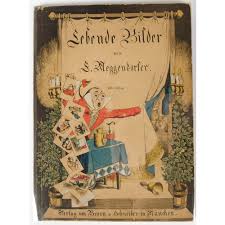Lothar Meggendorfer
Listen to the Recess! Clip
| Author | Rita Smith |
| Air Date | 7/29/2003 |

Lothar Meggendorfer Transcript
Movable books for children have been around since the late 18th century. Peter Haining, in his history of movable books, believes that during the last two decades of the nineteenth century, the German, Lothar Meggendorfer, created the most elaborate and ingenious movables ever produced.1 The Germans had developed superior technical and printing skills, so it isn’t surprising that the crowning achievements in movable books should have come from them, and Meggendorfer’s books with their delightful originality, sophistication and humor were the best of the best. These actions hinge on an innovative and complex use of interlocked parts and intricate rivets and levers hidden between the color page and the support page. The earliest of his productions are hand-colored, but in later publications, chromolithography gives the illustrations a warm, soft tint.
Critic Eric Quale describes the magic these books exerted on children and adults alike: “They were marvels of ingenuity,” he writes, “a single tab at the side or bottom of the page made apes swing from trees, crocodiles swallow little boys, umbrellas open, boats roll and houses collapse. Usually several movements took place at the same time on the same page: a rearing horse,” for example, “would throw its rider while his companion would successfully jump a fence.”2
One of Meggendorfer’s most magnificent volumes is about a circus, and tabs along the bottom of the pages set into motion a dazzling array of performers and animals into different and complicated routines. Of course, as with any movable book, if a child was careless or pulled too hard on the tabs, the whole thing would be ruined. Knowing this, Meggendorfer composed a little rhyme to warn his young readers to be gentle when operating the tabs and levers, and included it at the beginning of some of his books:
With this book, my own dear child Are various pictures gay
Their limbs they move with gestures wild,
As with them you do play.
But still they are of paper made,
And therefore, I advise,
That care and caution should be paid,
Lest woe and grief arise;
Both you and pictures then would cry
To see what harm is done
And sigh would follow after sigh
Because you’ve spoilt your fun.
Not all children heeded his warning. Although from the 1880s to the 1900s, Meggendorfer’s works enjoyed brisk sales and many reprintings, a book of his today in good condition is a rarity and among the most desirable of all items to collectors of children’s books.
Notes
1Haining, p. 65.
2 Quoted in Haining, p. 65
Sources
Haining, Peter. Movable Books, An Illustrated History. London: New English Library. 1979, p. 65.http://www.lib.virginia.edu/speccol/exhibits/popup/meggen.html